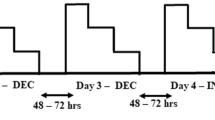Abstract
The criteria of max\(\dot V_{O_2 } \) and max O2 D which are traditionally used in studying aerobic and anaerobic work capacity, have the different dimensions. While max\(\dot V_{O_2 } \) is an index of the power of aerobic energy output, max O2 D assesses the capacity of anaerobic sources. For a comprehensive assessment of physical working capacity of athletes, both aerobic and anaerobic capabilities should be represented in three dimensions,i.e. in indexes of power, capacity and efficiency. Experimental procedures have been developed for assessing these three parameters in treadmill running tests.
It is proposed to assess anaerobic power by measuring excess CO2, concurrently with determination of max\(\dot V_{O_2 } \). Maximal aerobic capacity is established as the product of max\(\dot V_{O_2 } \) by the time of max\(\dot V_{O_2 } \) maintenance determined in a special test with running at critical speed. The ergometric criteria derived on the basis of the tests proposed, may be used for systematization of various physical work loads.
Similar content being viewed by others
References
Agnevik, G., Karlsson, J., Diamant, B., Saltin, B.: Oxygen debt, lactate in blood and muscle tissue during maximal exercise in man. In: Biochemistry of exercise, L. Poortmans, ed. pp. 62–65. Basel-New York: Karger 1969
Åstrand, P.-O.: Experimental studies of physical working capacity in relation to sex and age. Copenhagen: Munksgaard 1952
Ettema, J. H.: Limits of human performance and energy production. Int. Z. angew. Physiol.22, 45–54 (1966)
Farfel, V. S., Michailov, V. V.: Maximal oxygen consumption as criterion of the capacity of oxidative processes and total work capacity of the organism. In: Oxygen regime of the organism and its regulation [in Russian], pp. 264–270. Kiev: Naukovadumka 1966
Gandelsman, A. B.: Physiological fundamentals of top athletes performances in long-term cyclical muscular exercise [in Russian]. Teoriya i praktika fiz. kultury5, 61 (1968)
Gerschler, W.: Grundlagen und Struktur des anaeroben Trainings. Sportarzt und Sportmed.2, 499–505 (1968)
Helbing, G., Nowacki, P. E.: Die maximale Sauerstoffschuld als Leistungskriterium. XVI. Weltkongreß für Sportmedizin in Hannover, Teil I, S. 133 (1966)
Henry, F. M., Fitzhenry, J. R.: Oxygen metabolism of moderate exercise, with some observations on the effects of tobacco smoking. J. appl. Physiol.2, 464–468 (1950)
Hollmann, W.: Höchst- und Dauerleistungsfähigkeit des Sportlers. München: Barth 1963
Hollmann, W., Venrath, H.: Experimentelle Untersuchungen zur Bedeutung cines Trainings unterhalb und oberhalb der Dauerbelastungsgrenze. In: W. Körbset al., Hrsg., Carl Diem-Festschrift, Frankfurt (Main) (1962)
Issekutz, B., Birkhead, N., Rodahl, K.: Use of respiratory quotients in assessment of aerobic work capacity. J. appl. Physiol.17, 47–50 (1962)
Ivanov, V. S.: Studies of aerobic and anaerobic functions by exhaustive muscular activity of cyclic events (in speed skating) [in Russian]. Dissertation, Moscow (1970)
Komata, G.: The relation between maximum oxygen debt and scudding ability. Jap. J. Phys. Fitness5, 176–179 (1956)
Margaria, R.: Assessment of physical activity in oxidative and anaerobic maximal exercise. Int. Z. angew. Physiol.22, 115–124 (1966)
Michailov, V. V.: Problems of endurance of athletes in cyclic muscular exercise [in Russian]. Teoriya i praktika fiz. kultury1, 55 (1968)
Naimark, A., Wasserman, K., McIlroy, M.: Continuous measurements of ventilatory exchange ratio during exercise. J. appl. Physiol.19, 644–652 (1964)
Pfeifer, H.: Grundlagen und Methoden des Ausdauertrainings. In: Trainingslehre, S. 149–164. Berlin: Sportverlag 1969
Rahn, H.: The gas stores of the body with particular reference to carbon dioxide. In: Man's dependence on the earthly atmosphere, pp. 297–304. New York: Macmillan 1962
Scherrer, M.: Acid-base imbalance and gas exchange during heavy work. In: Biochemistry of exercise, J. Poortmans, ed. pp. 2–14. New York: Karger 1969
Shepard, R. J., Allen, C., Benade, A., Davies, C., Di Prampero, P., Hedman, R., Merriman, J., Myhre, K., Simmona, R.: Maximal oxygen consumption: international criterion of cardiac-respiratory capacity. Bull. Wld Hlth Org.38, 760–768 (1968)
Shirkovets, E. A.: Studies of special work capacity of man in sports swimming [in Russian]. Dissertation, Moscow (1968)
Valentin, H., Venrath, H., Balodimos, J., Giovanelli, J.: Die maximale Sauerstoffaufnahme. Ein praktisch wichtiger Bruttowert im Vita-maxima Bereich zur Beurteilung der Belastung und Leistungsfähigkeit von Herz und Kreislauf. Arch. Kreisl.-Forsch.44, 770 (1955)
Volkov, N. I.: Maximum anaerobic work capacity of athletes. In: Materials of the 8th Scientific Conference on the Morphology, Physiology and Biochemistry of Muscular Activity [in Russian], p. 72, Moscow (1964)
Volkov, N. I.: Energy criteria of endurance of athletes. In: Materials of the 11th All-Union Scientific Conference on the Physiology, Morphology, Biochemistry and Biomechanics of Muscular Activity [in Russian], p. 86, Sverdlovsk (1970)
Whipp, B. J., Wasserman, K.: Efficiency of muscular work. J. appl. Physiol.26, 644–648 (1969)
Williams, C. G., Wyndham, C. H., Kok, R., Rahden, M. J. E.: Effect of training on maximum oxygen intake and on anaerobic metabolism in man. Int. Z. angew. Physiol.24, 18–23 (1967)
Author information
Authors and Affiliations
Rights and permissions
About this article
Cite this article
Volkov, N.I., Shirkovets, E.A. & Borilkevich, V.E. Assessment of aerobic and anaerobic capacity of athletes in treadmill running tests. Europ. J. Appl. Physiol. 34, 121–130 (1975). https://doi.org/10.1007/BF00999924
Received:
Issue Date:
DOI: https://doi.org/10.1007/BF00999924




